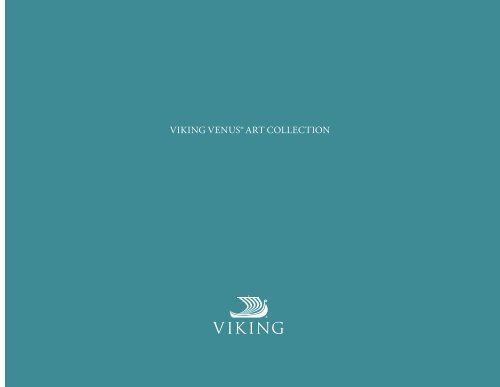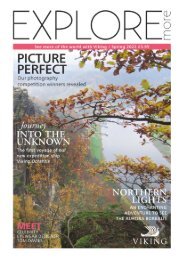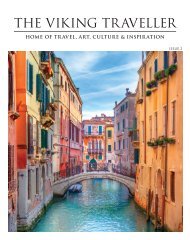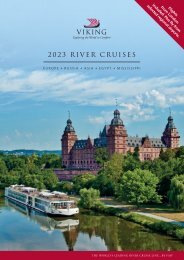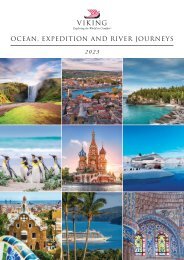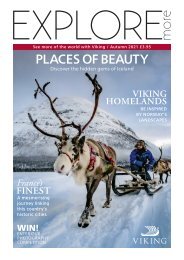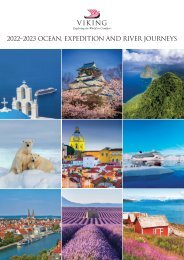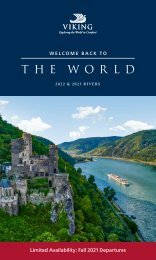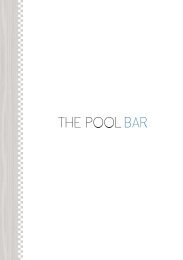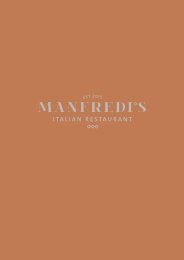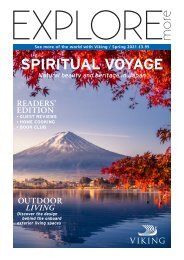Create successful ePaper yourself
Turn your PDF publications into a flip-book with our unique Google optimized e-Paper software.
VIKING VENUS® ART COLLECTION<br />
129197_PRESSFILE-130701135-<strong>Viking</strong>-<strong>Venus</strong>-<strong>Art</strong>-<strong>Catalog</strong>_R1.indd 3<br />
2/25/21 10:50 PM
EXPERIENCE YOUR ONBOARD VIKING ART GUIDE<br />
Engage with our onboard art collection and Scandinavian-inspired spaces. The <strong>Viking</strong> <strong>Art</strong> Guide app provides<br />
insightful commentary from your host, Karine Hagen, as well as a variety of curators and experts, to create a<br />
personal, self-guided experience.<br />
If you see the headphone icon next to a piece of artwork, open up the <strong>Viking</strong> <strong>Art</strong> Guide app on your phone or<br />
tablet and enter the number beneath the icon to learn more.<br />
129197_PRESSFILE-130701135-<strong>Viking</strong>-<strong>Venus</strong>-<strong>Art</strong>-<strong>Catalog</strong>_R1.indd 4<br />
2/25/21 11:08 PM
CONTENTS<br />
06 EXPLORERS’ LOUNGE<br />
22 WINTERGARDEN<br />
26 WORLD CAFÉ<br />
28 MAIN STAIRS<br />
32 CORRIDORS<br />
34 THE LIVING ROOM<br />
40 ATRIUM<br />
46 THE RESTAURANT ENTRANCE<br />
52 THE RESTAURANT<br />
80 THE CHEF’S TABLE<br />
86 MANFREDI’S® ITALIAN RESTAURANT<br />
88 HAIR SALON<br />
92 FITNESS CENTER<br />
94 THE SPA<br />
98 STATEROOMS<br />
129197_PRESSFILE-130701135-<strong>Viking</strong>-<strong>Venus</strong>-<strong>Art</strong>-<strong>Catalog</strong>_R1.indd 5<br />
2/25/21 10:50 PM
EXPLORERS’ LOUNGE | DECKS 7–8<br />
SIGRID UNDSET<br />
Sigrid Undset is one of the most influential authors in Norwegian history. She is best known for the historical and ethnological accuracy with which she depicted<br />
medieval Scandinavian society, as well as her active role in public debates on women’s rights, religion and Nazism. Her extensive body of work includes novels, short<br />
stories, essays, hagiographies, autobiographical texts, poems and plays.<br />
Undset was born in 1882 in Kalundborg, Denmark, as the eldest of three daughters to Norwegian archaeologist Ingvald Martin Undset and his Danish wife, Charlotte<br />
Gyth. When Undset was two, the family moved to Kristiania (now Oslo), Norway, and she spent the remainder of her childhood there. During those early years, she<br />
was introduced to her father’s work and developed an interest in ancient and medieval history. However, with her father’s death in 1893, the family was faced with<br />
economic hardship, and Undset made the decision to find employment rather than pursue higher education. Thus, from the age of 17 to 27, she worked as a secretary<br />
at an engineering firm, all the while crafting her writing skills.<br />
In 1907, she published her first book, Marta Oulie. And two years later, when the Norwegian government granted her a travel scholarship, Undset left her secretarial<br />
position and made her way to Italy. It was during this time that she not only met the painter Anders Castus Svarstad, whom she married in Antwerp, Belgium, in 1912,<br />
but she also had her major breakthrough with the publication of Jenny in 1911. The novel offered meticulous accounts of poverty, urbanization and the bourgeoisie,<br />
but its open exploration of female sexuality was considered highly controversial. Undset’s opinions on women’s rights, claiming modernity and capitalism were some<br />
of the main reasons for the plight of women, were ahead of their time and hard to accept for many of her contemporaries.<br />
Undset also viewed modern individuality and capitalism as the sources of alienation and societal deterioration. As a result, she looked to the Catholic Middle Ages for<br />
inspiration, both as an author and in her daily life, and ended up converting to Roman Catholicism in 1924. This conversion greatly impacted her subsequent work as a<br />
writer and her voice in the Norwegian public sphere, becoming a leading figure on topics regarding the Roman Catholic Church.<br />
Between 1920 and 1922, Undset released one of Norway’s most celebrated literary masterpieces: the Kristin Lavransdatter trilogy. The three volumes—The Wreath<br />
(1920), The Wife (1921) and The Cross (1922)—follow the life of their eponymous heroine, a farmer’s daughter, from birth to death, through her hardships and the<br />
solace she finds in the Catholic faith. Among its main themes is the conflict between individuality and faith; that is, whether Kristin should follow her heart’s desires or<br />
the words of God. In 1928, it was primarily for this body of work and its depictions of life in Norway during the Middle Ages that Undset was awarded the Nobel Prize<br />
in Literature. To date, Undset is one of three Norwegian novelists and the only Norwegian woman to have received the prize.<br />
From the early 1930s, Undset was vocal about her critique of Adolf Hitler and Nazi Germany, as well as her opposition to the regime. Consequently, her works were<br />
banned in Germany, and in 1940, following the Nazi occupation of Norway, she was forced to flee to the United States. During her time there, she tirelessly fought for<br />
Norwegian independence, holding speeches and writing articles on politics and the war. When World War II ended in 1945, Undset returned to Norway, where she<br />
lived until her death in 1949.<br />
LEFT: SIGRID UNDSET IN HER HOME, BJERKEBÆK | 1923<br />
RIGHT: SIGRID UNDSET IN HER TWENTIES | 1907<br />
6<br />
129197_PRESSFILE-130701135-<strong>Viking</strong>-<strong>Venus</strong>-<strong>Art</strong>-<strong>Catalog</strong>_R1.indd 6<br />
2/25/21 11:08 PM
7<br />
129197_PRESSFILE-130701135-<strong>Viking</strong>-<strong>Venus</strong>-<strong>Art</strong>-<strong>Catalog</strong>_R1.indd 7<br />
2/25/21 10:50 PM
EXPLORERS’ LOUNGE | DECKS 7–8<br />
HEDEVIG ANKER<br />
1969 NORWAY PHOTOGRAPHY<br />
Hedevig Anker is a well-recognized Norwegian photographer, mostly known for her quiet, beautiful and poetic images of empty rooms. Characteristic<br />
of Anker’s photography is the way in which she sees the spaces that she photographs; the dark corner under a staircase, a crack in the floor, a living room<br />
through a keyhole or the small gap between the back of a cabinet and the wall. Characterized by the juxtaposition of crystal clear light and a painterly blur,<br />
her images are at once abstract compositions and intimate photographic studies of our everyday life surroundings.<br />
8<br />
129197_PRESSFILE-130701135-<strong>Viking</strong>-<strong>Venus</strong>-<strong>Art</strong>-<strong>Catalog</strong>_R1.indd 8<br />
2/25/21 11:08 PM
BJERKEBÆK 9 | 2016<br />
BJERKEBÆK 12 | 2018<br />
9<br />
129197_PRESSFILE-130701135-<strong>Viking</strong>-<strong>Venus</strong>-<strong>Art</strong>-<strong>Catalog</strong>_R1.indd 9<br />
2/25/21 10:50 PM
EXPLORERS’ LOUNGE | DECKS 7–8<br />
STATSRAAD LEHMKUHL<br />
Statsraad Lehmkuhl is not only the largest square-rigged tall ship in Norway but also the oldest still in operation in the world. This three-masted steel bark was<br />
constructed in 1914 by the J. C. Tecklenborg AG shipbuilding company in present-day Bremerhaven, Germany, with a gross tonnage of 1,516. She originally<br />
bore the name Grossherzog Friedrich August, and with the onset of World War I, entered into service as a stationary training ship. Following Germany’s defeat,<br />
Grossherzog Friedrich August was ceded to Great Britain in 1920. However, not long after, she was acquired by the Norwegian Shipowners’ Association and<br />
renamed Statsraad Lehmkuhl in honor of the man who organized the purchase: Kristofer Lehmkuhl, the director of Det Bergenske Dampskibsselskap (The<br />
Bergen Steamship Company). By 1923, she was operating as a Norwegian sail training vessel—first for the Bergen School Ship Foundation (until 1967),<br />
then shipowner Hilmar Reksten (1968–1973) and finally the Statsraad Lehmkuhl Foundation (from 1978 onward). Since the foundation took ownership<br />
of Statsraad Lehmkuhl, she has been chartered by the Royal Norwegian Naval Academy, schools and various other organizations for training purposes.<br />
Today, Statsraad Lehmkuhl is able to berth up to 150 trainees, along with a maximum of 40 crew members.<br />
10<br />
129197_PRESSFILE-130701135-<strong>Viking</strong>-<strong>Venus</strong>-<strong>Art</strong>-<strong>Catalog</strong>_R1.indd 10<br />
2/25/21 11:08 PM
11<br />
129197_PRESSFILE-130701135-<strong>Viking</strong>-<strong>Venus</strong>-<strong>Art</strong>-<strong>Catalog</strong>_R1.indd 11<br />
2/25/21 10:50 PM
12<br />
129197_PRESSFILE-130701135-<strong>Viking</strong>-<strong>Venus</strong>-<strong>Art</strong>-<strong>Catalog</strong>_R1.indd 12<br />
2/25/21 11:08 PM
EXPLORERS’ LOUNGE | DECKS 7–8<br />
CHRISTIAN RADICH<br />
Christian Radich is a three-mast full-rigged tall ship measuring a total of 240 feet (73 m) in length. She was commissioned in 1935 by the Kristiania School<br />
Ship Foundation to serve as its new training vessel—a costly venture made possible by the wealthy lumber merchant Simeon Christian Radich (1822–1889).<br />
Half a century earlier, Simeon had left a generous sum to the foundation for just this purpose, and his only stipulation was that the ship bore his name.<br />
Within two years, construction on Christian Radich was completed at the Framnæs Mekaniske Verksted shipyard in Sandefjord, Norway, and she officially<br />
entered into service in 1937. She could berth up to 90 cadets, along with a 15- to 20-member crew, and her lower deck was equipped with various facilities,<br />
including a large galley, a carpentry shop and a machine shop, to help instruct the trainees in the ways of a sailor.<br />
Save for the few years in which she was seized by the Germans during World War II, Christian Radich sailed the seas as a school ship for the Norwegian<br />
merchant navy until 1998. Since then, she has served as a charter vessel as well as a sail training ship for Norway’s Naval Officer Candidate School, maritime<br />
students and at-risk youth. She has also participated in regattas nearly every summer since the first Tall Ships Race launched in 1956, winning numerous<br />
first-place victories. However, it was through her starring role in the 1958 documentary film Windjammer that she earned her place on the world stage.<br />
13<br />
129197_PRESSFILE-130701135-<strong>Viking</strong>-<strong>Venus</strong>-<strong>Art</strong>-<strong>Catalog</strong>_R1.indd 13<br />
2/25/21 10:50 PM
EXPLORERS’ LOUNGE | DECKS 7–8<br />
SØRLANDET<br />
Sørlandet was constructed between 1925 and 1927 at the Høivolds Mekaniske Verksted shipyard in Kristiansand, Norway. The full-rigged tall ship—the<br />
oldest still in operation in the world—bears the name of the southern Norwegian region from which she hails and reaches a total length of 210 feet (64 m).<br />
When her benefactor, shipowner Oluf Andreas Tollefsen Skjelbred, set up an endowment of £25,000 in 1918, he envisioned an institution that would<br />
prepare youth for a professional career at sea. And with a capacity for 80 cadets, Sørlandet did just that, training thousands of young seafarers for Norway’s<br />
merchant navy. However, during World War II, her role as a school ship had to be put on hold; she was briefly stationed in the port of Horten as a depot<br />
ship for the Royal Norwegian Navy until she was overtaken by the Germans in 1940. By the war’s end, Sørlandet was in a state of disrepair, but she was fully<br />
restored and back in commission in 1948 to continue her endeavors in maritime education. After passing through numerous hands over the next three<br />
decades, the Stiftelsen Fullriggeren Sørlandet foundation was formed in 1981 to take over the management of Sørlandet’s operations. As of 2015, she has<br />
been functioning as the A+ World Academy—an international high school at sea.<br />
14<br />
129197_PRESSFILE-130701135-<strong>Viking</strong>-<strong>Venus</strong>-<strong>Art</strong>-<strong>Catalog</strong>_R1.indd 14<br />
2/25/21 11:08 PM
15<br />
129197_PRESSFILE-130701135-<strong>Viking</strong>-<strong>Venus</strong>-<strong>Art</strong>-<strong>Catalog</strong>_R1.indd 15<br />
2/25/21 10:50 PM
16<br />
129197_PRESSFILE-130701135-<strong>Viking</strong>-<strong>Venus</strong>-<strong>Art</strong>-<strong>Catalog</strong>_R1.indd 16<br />
2/25/21 11:08 PM
EXPLORERS’ LOUNGE | DECKS 7–8<br />
SKIBLADNER<br />
Skibladner is a historic side-wheel paddle steamer, fondly known among the locals as “the White Swan of Mjøsa.” Her name was inspired by Skíðblaðnir,<br />
the mythological ship that belonged to Freyr, the Norse god of sunshine, rain, prosperity, peace and virility. According to legend, no other ship equaled<br />
the craftsmanship of Skíðblaðnir. She was large enough to carry all the gods of Aesir and had the magical ability to sail as easily on water as on land and<br />
in the air, as well as fold into a size small enough to fit into a pocket when not in use.<br />
Construction on Skibladner herself began in 1854 at the Motala Verksted shipyard in Sweden, and upon her completion in 1856, she was transported<br />
to Eidsvoll, Norway, where she was reassembled. On August 2 of that same year, she embarked on her inaugural voyage on Mjøsa lake, delivering<br />
passengers and freight from Lillehammer, Gjøvik and Hamar to Eidsvoll and its awaiting railway station. Three decades into her service, Skibladner<br />
underwent a renovation in 1888 that replaced her green exterior with her present white color while also extending her length to 165 feet (50 m) and<br />
equipping her with new machinery, including her current steam engine. Today, Skibladner still plies those same waters to those same ports, making<br />
her the world’s oldest continuously operating paddle steamer. And since 2006, she has been a protected vessel under the Cultural Heritage Act—one<br />
of the first two ships granted this status by the Norwegian National Heritage Board.<br />
17<br />
129197_PRESSFILE-130701135-<strong>Viking</strong>-<strong>Venus</strong>-<strong>Art</strong>-<strong>Catalog</strong>_R1.indd 17<br />
2/25/21 10:50 PM
EXPLORERS’ LOUNGE | DECKS 7–8<br />
ALASTAIR MILLER<br />
1957 UK PHOTOGRAPHY<br />
Alastair Miller is an award-winning British photographer based in Paris. His first true passion was the sea. After a brief career as a navigator in<br />
the Merchant Navy, he began photographing opera and classical music events and venues in London. He then spent more than a decade in Paris,<br />
photographing people and places for lifestyle magazines and newspapers, principally The Times and The Sunday Times. Travel and nature are<br />
dear to his heart. “I always search for the unexpected, the small detail in the larger landscape—whether a drop of rain on glass or the light across<br />
a sandstone facade.” Among his favorite subjects are the Norwegian mountains and fjords, canals of Venice at dawn, rooftops of Barcelona and<br />
church domes of St. Petersburg.<br />
18<br />
129197_PRESSFILE-130701135-<strong>Viking</strong>-<strong>Venus</strong>-<strong>Art</strong>-<strong>Catalog</strong>_R1.indd 18<br />
2/25/21 11:08 PM
NORWAY NATURE | 2014<br />
19<br />
129197_PRESSFILE-130701135-<strong>Viking</strong>-<strong>Venus</strong>-<strong>Art</strong>-<strong>Catalog</strong>_R1.indd 19<br />
2/25/21 10:50 PM
EXPLORERS’ LOUNGE | DECKS 7–8<br />
ISABEL TELLEFSEN<br />
1968 NORWAY PHOTOGRAPHY<br />
Norwegian artist Isabel Tellefsen is an autodidact photographer. She never goes anywhere without her camera, which often leads to unexpected<br />
opportunities. Inspired by landscapes and light, her many travels abroad and her family, Tellefsen’s images capture the silent grandeur of Norwegian<br />
nature. With her watchful eye, Tellefsen manages to freeze the tides, the northern lights, the processes of decomposition and the seasons, resulting<br />
in intimate and breathtaking moments between the camera and the forces of nature.<br />
20<br />
129197_PRESSFILE-130701135-<strong>Viking</strong>-<strong>Venus</strong>-<strong>Art</strong>-<strong>Catalog</strong>_R1.indd 20<br />
2/25/21 11:08 PM
LEFT AND MIDDLE: SUMMER LIGHT BY THE SEA | 2020<br />
RIGHT: WINTER LIGHT BY THE SEA | 2018<br />
21<br />
129197_PRESSFILE-130701135-<strong>Viking</strong>-<strong>Venus</strong>-<strong>Art</strong>-<strong>Catalog</strong>_R1.indd 21<br />
2/25/21 10:50 PM
WINTERGARDEN | DECK 7<br />
TRYM IVAR BERGSMO<br />
1962 NORWAY PHOTOGRAPHY<br />
Trym Ivar Bergsmo is a Norwegian nature photographer and video artist. He is especially known for his pictures of the Lofoten Islands, Svalbard and northern<br />
Norway, which he has made his playground. Through various approaches, he has immersed himself in the elements of this landscape, exploring the relationship<br />
between nature, the people and their lives in the north. His artistic expression varies between abstract observations of the landscape to raw documentary<br />
portraits of a reindeer herder and his flock. However, central to all of Bergsmo’s work is the experience of the northern lights and creating light out of darkness.<br />
His photography has resulted in several books and exhibitions, and he has been involved in a variety of multimedia and theater projects.<br />
OUR GIANTS #13230 | 2020<br />
22<br />
129197_PRESSFILE-130701135-<strong>Viking</strong>-<strong>Venus</strong>-<strong>Art</strong>-<strong>Catalog</strong>_R1.indd 22<br />
2/25/21 11:08 PM
23<br />
129197_PRESSFILE-130701135-<strong>Viking</strong>-<strong>Venus</strong>-<strong>Art</strong>-<strong>Catalog</strong>_R1.indd 23<br />
2/25/21 10:50 PM
WINTERGARDEN | DECK 7<br />
NICOLAUS WIDERBERG<br />
1960 NORWAY GLASS<br />
Nicolaus Widerberg is a renowned Norwegian sculptor, painter and graphic artist. Inspired by ancient Greek and Egyptian sculptures, Widerberg has a footing<br />
in the figurative tradition of art and is interested in form and balance. He creates poetic works in glass, bronze, granite and marble in a classical, figurative style.<br />
Central to Widerberg’s art are depersonalized human figures, heads and torsos—often of a male and a female character. He uses the human body as a form<br />
through which he can communicate moods and a sense of presence. Widerberg also strives to create things that are “alive,” and by giving life to dead material,<br />
he hopes to make a statement about being a living human being.<br />
Widerberg is the son of the famous Norwegian artist Frans Widerberg and the brother of musician and artist Thomas Widerberg.<br />
BEING | 2015<br />
24<br />
129197_PRESSFILE-130701135-<strong>Viking</strong>-<strong>Venus</strong>-<strong>Art</strong>-<strong>Catalog</strong>_R1.indd 24<br />
2/25/21 11:08 PM
25<br />
129197_PRESSFILE-130701135-<strong>Viking</strong>-<strong>Venus</strong>-<strong>Art</strong>-<strong>Catalog</strong>_R1.indd 25<br />
2/25/21 10:50 PM
26<br />
129197_PRESSFILE-130701135-<strong>Viking</strong>-<strong>Venus</strong>-<strong>Art</strong>-<strong>Catalog</strong>_R1.indd 26<br />
2/25/21 11:08 PM
WORLD CAFÈ | DECK 7<br />
KATE JENKINS<br />
1971 UK KNIT AND CROCHET<br />
Kate Jenkins is an innovative British artist known for her unique knitted depictions of popular dishes and her nostalgic take on everyday items, reinvented<br />
with a comedic touch. In 1995, she graduated from the University of Brighton with a degree in fashion and textile. Before establishing her own fashion<br />
and homeware label in 2003, she was a successful knitting consultant and sold her designs to fashion labels including Marc Jacobs, Missoni, Sonia Rykiel<br />
and Donna Karan. Jenkins now works out of Cardigan, her studio and shop in Brighton, England, and her work is collected worldwide.<br />
SQUID AND SEAFOOD CIOPPINO | 2020<br />
27<br />
129197_PRESSFILE-130701135-<strong>Viking</strong>-<strong>Venus</strong>-<strong>Art</strong>-<strong>Catalog</strong>_R1.indd 27<br />
2/25/21 10:50 PM
MAIN STAIRS | DECKS 1–8<br />
THE BAYEUX TAPESTRY<br />
Dating back to the 11th century, the Bayeux Tapestry is one of the most famous works of art in the Western world from medieval times, and one of the<br />
supreme achievements of the Norman Romanesque. It is a historic monument that documents and retraces a series of events that took place in Normandy and<br />
in England in the second half of the 11th century. The Bayeux Tapestry documents William the Conqueror’s invasion of England and the death of Anglo-Saxon<br />
King Harold in the Battle of Hastings. French descendants of <strong>Viking</strong> leaders and kings played pivotal roles. King Harold was a son of Earl Godwin of Wessex,<br />
appointed by Knut the Great, son of Svein Forkbeard and grandson of Harald Bluetooth—both <strong>Viking</strong>s. Before the battle, at Stamford Bridge, Harold had<br />
fought off legendary <strong>Viking</strong> warrior King Hardrada of Norway. William the Conqueror led an invading army. A descendant of the <strong>Viking</strong> chieftain Rollo, William<br />
shook England’s shore when he arrived with a fleet of 600 ships, many of which were built in the traditional <strong>Viking</strong> clinker style. Soon after Harold’s demise,<br />
William took the throne of England. Key scenes depict Harold’s coronation, William’s ships crossing the English Channel and the Battle of Hastings.<br />
The origins of the Bayeux Tapestry are uncertain. The first written record of the tapestry is from 1476, when it was recorded in the cathedral treasury at<br />
Bayeux, as “a very long and narrow hanging on which are embroidered figures and inscriptions comprising a representation of the conquest of England.”<br />
The Bayeux Tapestry was most likely commissioned in the 1070s by Bishop Odo of Bayeux, half brother of William the Conqueror. The original tapestry is<br />
over 70 meters long and depicts 626 human figures, 190 horses, 35 dogs, 506 other birds and animals, 33 buildings, 37 ships and 37 trees or groups of trees,<br />
with 57 Latin inscriptions. Although it is called a tapestry, it is in fact embroidered, stitched not woven, in woolen yarns on linen. Some historians argue that<br />
it was embroidered in Kent, England.<br />
The Bayeux Tapestry has survived almost intact for over nine centuries, and the original is today preserved and displayed in Bayeux, Normandy, France. Its<br />
exceptional length, the harmony and brilliance of its colors, its exquisite workmanship and the fascinating history it recounts, makes the Bayeux Tapestry<br />
endlessly captivating.<br />
28<br />
129197_PRESSFILE-130701135-<strong>Viking</strong>-<strong>Venus</strong>-<strong>Art</strong>-<strong>Catalog</strong>_R1.indd 28<br />
2/25/21 11:08 PM
BAYEUX TAPESTRY RENDITION | 2014<br />
29<br />
129197_PRESSFILE-130701135-<strong>Viking</strong>-<strong>Venus</strong>-<strong>Art</strong>-<strong>Catalog</strong>_R1.indd 29<br />
2/25/21 10:50 PM
MAIN STAIRS | DECKS 1–8<br />
STUDIO SEM SCULTORI ASSOCIATI SRL<br />
ITALY<br />
ITALIAN CARDOSO STONE<br />
Studio Sem was established in the 1950s by Sem Ghelardini, and is today recognized as one of the most important sculpture studios in Europe. When founding<br />
Studio Sem, Ghelardini’s vision was to create an inspirational space where young artists could learn and work alongside celebrated modern masters. Ghelardini’s<br />
passion for modern art and abstract forms has earned his studio a reputation as a pioneering and unique sculptor workshop. Today, the studio is directed by his<br />
youngest son, Pierangelo Ghelardini, and Keara McMartin.<br />
For more than 60 years, the studio has collaborated with artists and sculptors from all over the world to produce marble and granite works of all dimensions.<br />
Notable sculptors who have produced their sculptural work with the studio range from Henry Moore, César Baldaccini and Barry Flanagan to Helaine<br />
Blumenfeld, Peter Randall-Page and Damien Hirst, along with many other young emerging artists.<br />
For <strong>Viking</strong> <strong>Venus</strong>, the creative artisans of Studio Sem surveyed some of the thousands of beautifully etched runic stones scattered throughout Sweden, Norway<br />
and Denmark. From these, they selected nine panels and have reproduced them on rough stone faces, staying loyal to the original spirit of Norse runes. The aft<br />
stair niches are adorned with their finely wrought recreations.<br />
About Ancient <strong>Viking</strong> Runestones<br />
Thousands of runestones have been unearthed throughout Scandinavia and each provides a glimpse into a culture whose people believed in the protection<br />
of the gods. These masterful works of passion and art are among the treasured relics that bring us closest to understanding the <strong>Viking</strong>s: Inscriptions tell us the<br />
names of the people who lived and died during the <strong>Viking</strong> Age, information about their travels, and stories about their achievements and fate.<br />
Runes are much more than the written language of the <strong>Viking</strong>s; they are the oldest existing original works of writing in Scandinavia and thus provide hints<br />
about ancient culture and society. Though their precise origin is shrouded in mystery, symbols resembling runes appear as cave markings as early as the Late<br />
Bronze Age. It was not until about 200 AD that the runic alphabet emerged.<br />
Runes and Norse mythology are inextricably linked. The <strong>Viking</strong>s believed runes were created when Odin, leader of the gods and “Father of the Runes,” speared<br />
himself to Yggdrasil, the cosmic and omniscient World Tree, in hopes of receiving secret knowledge. Indeed, “rune” derives from the Old Norse word meaning<br />
“secret knowledge and wisdom.” We hope you gain your own insights about <strong>Viking</strong> culture as you browse our special onboard collection.<br />
BORNHOLM ROCK CARVINGS | 2020<br />
30<br />
129197_PRESSFILE-130701135-<strong>Viking</strong>-<strong>Venus</strong>-<strong>Art</strong>-<strong>Catalog</strong>_R1.indd 30<br />
2/25/21 11:08 PM
31<br />
129197_PRESSFILE-130701135-<strong>Viking</strong>-<strong>Venus</strong>-<strong>Art</strong>-<strong>Catalog</strong>_R1.indd 31<br />
2/25/21 10:51 PM
CORRIDORS<br />
FIN SERCK-HANSSEN<br />
1958 NORWAY PHOTOGRAPHY<br />
Fin Serck-Hanssen is a well-recognized Norwegian photographer. He is represented in a number of key art institutions, among others in the Victoria and Albert<br />
Museum; the National Museum of Photography, Film and Television in England; and in the Museum of Contemporary <strong>Art</strong> in Oslo, Norway. For <strong>Viking</strong>, Serck-<br />
Hanssen has traveled to many destinations on the <strong>Viking</strong> routes to photograph the shores and cities. Presented in large-scale black-and-white photography<br />
throughout the corridors, guests can enjoy scenes from the different ports, with their street life, characteristic architecture and natural surroundings.<br />
32<br />
129197_PRESSFILE-130701135-<strong>Viking</strong>-<strong>Venus</strong>-<strong>Art</strong>-<strong>Catalog</strong>_R1.indd 32<br />
2/25/21 11:08 PM
PORTS OF CALL | 2020<br />
33<br />
129197_PRESSFILE-130701135-<strong>Viking</strong>-<strong>Venus</strong>-<strong>Art</strong>-<strong>Catalog</strong>_R1.indd 33<br />
2/25/21 10:51 PM
34<br />
129197_PRESSFILE-130701135-<strong>Viking</strong>-<strong>Venus</strong>-<strong>Art</strong>-<strong>Catalog</strong>_R1.indd 34<br />
2/25/21 11:08 PM
THE LIVING ROOM | DECK 1<br />
EDVARD MUNCH<br />
1863–1944 NORWAY ETCHING AND DRYPOINT ON COPPERPLATE<br />
Edvard Munch was a Norwegian expressionist painter and printmaker, and is recognized today as perhaps one of the world’s most famous artists. Munch<br />
began to paint early at the age of 12 and lived a life devoted to art. His artistic oeuvre extends over a period of more than 60 years, during which he<br />
painted over 2,000 paintings and made tens of thousands of prints. Munch can be said to be almost as famous for his life as he is for his art. In periods, he<br />
lived a nomadic and turbulent bohemian life, together with the Kristiania Bohemians in the Norwegian capital and with the group around the wine bar<br />
Zum schwarzen Ferkel in Berlin. During his long life as an artist, Munch experimented with the different painterly directions of his time, but it is first and<br />
foremost as a symbolist and expressionist he has become famous. Paintings such as The Scream, Madonna, Death in the Sickroom and The Dance of Life are<br />
highly praised icons in art history.<br />
THE SICK CHILD | 1896<br />
GERD WOLL, EDVARD MUNCH: THE COMPLETE GRAPHIC WORKS #59<br />
35<br />
129197_PRESSFILE-130701135-<strong>Viking</strong>-<strong>Venus</strong>-<strong>Art</strong>-<strong>Catalog</strong>_R1.indd 35<br />
2/25/21 10:51 PM
THE LIVING ROOM | DECK 1<br />
DANNY LARSEN<br />
1981 NORWAY ACRYLIC ON CANVAS<br />
Danny Larsen’s paintings emulate the dark beauty and historic landscapes of Scandinavia. Prior to becoming a full-time artist, Larsen had an extensive career as<br />
a professional snowboarder. As Larsen’s focus shifted from snowboarding to visual art, his early illustrative style became more embedded in natural landscapes<br />
and Norwegian folklore. His exquisitely detailed penmanship depicts dark and atmospheric scenes of rural Norway, evoking a spiritual, ghostly tranquility.<br />
Larsen has exhibited internationally in Paris, London and Austria. He also has a close partnership with the Michelin-starred restaurant Maaemo in Oslo and has<br />
been commissioned to produce paintings and various designs for the establishment.<br />
WHEN THE SHADOWS GROW LONG | 2020<br />
36<br />
129197_PRESSFILE-130701135-<strong>Viking</strong>-<strong>Venus</strong>-<strong>Art</strong>-<strong>Catalog</strong>_R1.indd 36<br />
2/25/21 11:08 PM
37<br />
129197_PRESSFILE-130701135-<strong>Viking</strong>-<strong>Venus</strong>-<strong>Art</strong>-<strong>Catalog</strong>_R1.indd 37<br />
2/25/21 10:51 PM
THE LIVING ROOM | DECK 1<br />
WORKS BY NORWEGIAN CRAFT ARTISTS<br />
The Nordic countries are renowned for their mastery of designing and fabricating a variety of simple yet elegant home furnishings. Whether a chair or a ceramic<br />
vase, handmade or machine made, Scandinavian artisans and designers long believed that well-crafted, affordable and aesthetically pleasing objects could enhance<br />
the quality of everyday life.<br />
While many designers in continental Europe and the United States took a more austere, machine-inspired approach to modernism, Scandinavian designers imbued<br />
their furnishings and craft ware with warmth. Many pieces were influenced by nature and made with organic materials. The general public welcomed this less<br />
severe, more palatable approach, and the demand for Scandinavian-designed items soared, particularly in the late 1940s and 1950s.<br />
In the 1970s, Norwegian craft artists experienced a complete breakthrough as the perception of handicrafts changed dramatically in the Scandinavian countries.<br />
At this point, it was fully accepted that it was possible to use traditional craft materials, such as metal, glass, ceramics and textiles, as an artistic expression without<br />
taking utility into account. In many cases, the “object” could be demonstrably useless, both in its form and in the assembly of different materials. There is no doubt<br />
that this changing reaction to the requirement of utility was a clear liberation within the field of handicrafts.<br />
Norwegian handicrafts have in recent years gained a renewed interest from both the art scene and the general public. Glass and ceramic arts in particular have<br />
become increasingly popular, and an idea-based craftsmanship has gained more traction. Once a somewhat undefined phenomenon in the borderland between<br />
art and design, Norwegian crafts are today closely linked to visual art. While most young artists educated in the various arts are less comfortable defining their<br />
artistic practices within a particular direction, they are able to work with a wide range of materials, as well as different types of techniques and expressions. More<br />
established craft artists, on the other hand, have seen it as natural to organize themselves around a specific tradition and discipline, many specializing in a particular<br />
technique and receiving great recognition for this. These parallel conditions have contributed to the creation of an exciting dynamic between the definable and the<br />
fluid within the field. As a result, the interest in handicrafts as collectible objects has soared in recent years.<br />
Represented in The Living Room (Deck 1) and the Atrium (Deck 2) of <strong>Viking</strong> <strong>Venus</strong> is a collection of glass art, ceramics and more by recognized Norwegian craft<br />
artists. On display are examples of various artworks by Aron Irving Li, Vidar Koksvik, Anette Krogstad, Bjarne Nielsen, Karen Klim and Kari Mølstad, to mention a few.<br />
38<br />
129197_PRESSFILE-130701135-<strong>Viking</strong>-<strong>Venus</strong>-<strong>Art</strong>-<strong>Catalog</strong>_R1.indd 38<br />
2/25/21 11:08 PM
SIGN OF SPRING BY ARON IRVING LI | 2019<br />
39<br />
129197_PRESSFILE-130701135-<strong>Viking</strong>-<strong>Venus</strong>-<strong>Art</strong>-<strong>Catalog</strong>_R1.indd 39<br />
2/25/21 10:51 PM
ATRIUM | DECKS 2–3<br />
H.M. QUEEN SONJA OF NORWAY<br />
1937 NORWAY PHOTOGRAVURE<br />
H.M. Queen Sonja of Norway has retained a keen interest in art all her life. She studied art history at the University of Oslo, and has collected art for many years,<br />
building an impressive collection of contemporary art. Over the last several years, the Queen has discretely received instruction from two outstanding teachers,<br />
artists Ørnulf Opdahl and Kjell Nupen, who have taught her different artistic techniques such as watercolor, lithography, etching and intaglio. Working in<br />
modest formats, and trying out various techniques, the Queen’s work is inspired by her own interest in nature and photography, as well as Nupen’s colors and<br />
Opdahl’s dark mountains. There is a balanced quietness in her natural forms, where the abstract meets figuration and decoration.<br />
QUIET FORM | 2013<br />
40<br />
129197_PRESSFILE-130701135-<strong>Viking</strong>-<strong>Venus</strong>-<strong>Art</strong>-<strong>Catalog</strong>_R1.indd 40<br />
2/25/21 11:08 PM
41<br />
129197_PRESSFILE-130701135-<strong>Viking</strong>-<strong>Venus</strong>-<strong>Art</strong>-<strong>Catalog</strong>_R1.indd 41<br />
2/25/21 10:51 PM
42<br />
129197_PRESSFILE-130701135-<strong>Viking</strong>-<strong>Venus</strong>-<strong>Art</strong>-<strong>Catalog</strong>_R1.indd 42<br />
2/25/21 11:08 PM
ATRIUM | DECKS 2–3<br />
MAGNE FURUHOLMEN<br />
1962 NORWAY CERAMICS<br />
Magne Furuholmen is a well-known Norwegian artist, musician and composer, perhaps best known as the keyboardist of the pop band A-ha. In recent<br />
years, he has dedicated much of his time to his artistic practice. As a visual artist, Furuholmen works with paint, etching, woodcut, glass and ceramics, and<br />
his work has been exhibited around the world. In his artistic expression, Furuholmen experiments with the visual qualities of linguistic structures, text and<br />
letters, and seeks to recreate language as art. His idiom is modern, aesthetically and visually captivating.<br />
VENUS | 2020<br />
43<br />
129197_PRESSFILE-130701135-<strong>Viking</strong>-<strong>Venus</strong>-<strong>Art</strong>-<strong>Catalog</strong>_R1.indd 43<br />
2/25/21 10:51 PM
44<br />
129197_PRESSFILE-130701135-<strong>Viking</strong>-<strong>Venus</strong>-<strong>Art</strong>-<strong>Catalog</strong>_R1.indd 44<br />
2/25/21 11:08 PM
ATRIUM | DECKS 2–3<br />
KÅRE TVETER<br />
1922–2012 NORWAY OIL ON CANVAS<br />
Norwegian painter Kåre Tveter is known for his landscape paintings of winter and autumn scenery in pale white and soft pastel colors. With his minimal<br />
use of color and nuances of white, Tveter has become known as the “Painter of Light.” In his work, light becomes so much more than the transition<br />
between day and night—it takes its own meditative form and becomes a vessel for nature’s mysteries.<br />
Tveter’s motifs are primarily the poetry of light and the expression of personal feelings. What was most important to him was drawing out the essence<br />
of his experiences in nature, and he was particularly concerned with what he called “the inner light,” the light of the mind’s inner landscape. Tveter<br />
found his motifs from Svalbard in the high north of Norway to the woodlands of Finnskogen in the south of Norway and Sweden. He stayed true to this<br />
range of motifs, which he first entertained in 1957, throughout his life.<br />
WINTER EVENING, FINNSKOGEN | 1991<br />
45<br />
129197_PRESSFILE-130701135-<strong>Viking</strong>-<strong>Venus</strong>-<strong>Art</strong>-<strong>Catalog</strong>_R1.indd 45<br />
2/25/21 10:51 PM
THE RESTAURANT ENTRANCE | DECK 2<br />
LAURITZ HAALAND<br />
1855–1938 NORWAY OIL ON CANVAS<br />
Lauritz Haaland stands among Norway’s most revered marine painters. He was originally trained as a shipbuilder and even worked for a time at a shipyard<br />
in Bergen. It was perhaps then that his eyes were opened to the world of art, and he decided to make that his new profession. By the 1880s, Haaland had<br />
completed his formal education at Knud Bergslien’s School of Painting and the Royal Drawing School in Kristiania (now Oslo), along with a number of study<br />
trips in Europe, including Hamburg and Berlin, Germany.<br />
Haaland drew much of his inspiration from the fishing community of Kvitsøy, where he was born and lived for most of his life, as well as his background in<br />
shipbuilding. He quickly gained renown—both nationally and internationally—for his masterfully accurate depictions of the sea and coastal landscapes;<br />
the day-to-day operations of fisheries; and a wide range of waterborne vessels, from schooners and steamers to fishing and pilot boats. In his heyday,<br />
he participated in some of the time’s most prestigious exhibitions, including the Great International Fisheries Exhibition of 1883 in London, the Autumn<br />
Exhibition (also known as the National <strong>Art</strong> Exhibition) in Oslo from 1884 to 1891, the 1893 World’s Columbian Exposition in Chicago and the 1900<br />
Exposition Universelle in Paris. Today, Haaland’s historic paintings are still represented throughout Norway at the Stavanger Maritime Museum, the<br />
Norwegian Maritime Museum in Oslo and the Norwegian Fisheries Museum in Bergen, to name a few.<br />
LOBSTER TRAPPING | 1889<br />
46<br />
129197_PRESSFILE-130701135-<strong>Viking</strong>-<strong>Venus</strong>-<strong>Art</strong>-<strong>Catalog</strong>_R1.indd 46<br />
2/25/21 11:08 PM
47<br />
129197_PRESSFILE-130701135-<strong>Viking</strong>-<strong>Venus</strong>-<strong>Art</strong>-<strong>Catalog</strong>_R1.indd 47<br />
2/25/21 10:51 PM
THE RESTAURANT ENTRANCE | DECK 2<br />
LARS HERTERVIG<br />
1830–1902 NORWAY PEN AND WATERCOLOR ON PAPER<br />
Lars Hertervig was a Norwegian artist known for his unusual and original contributions to Norwegian National Romanticism in the 19th century. In modern<br />
times, his works have been praised as protomodernist, displaying both impressionist and expressionist characteristics, as well as elements of surrealism and<br />
symbolism. His paintings from Sunnhordland and Ryfylke, Norway, are widely acclaimed for their originality.<br />
He studied painting at the Düsseldorf <strong>Art</strong> Academy and had a promising career until his mental health began to deteriorate in the 1850s. And after being<br />
stripped of his economic rights in 1958, he ended up at a poorhouse in Stavanger. During the last 30 years of his life, Hertervig only worked with watercolor<br />
and gouache on paper due to economic difficulties—at times improvising his “canvas” by gluing together strips of paper with homemade rye flour paste.<br />
His breakthrough in the art world came in 1914 at the Jubilee Exhibition in Kristiania (now Oslo), 12 years after his death.<br />
BYBERGSTYKKET | 1858<br />
48<br />
129197_PRESSFILE-130701135-<strong>Viking</strong>-<strong>Venus</strong>-<strong>Art</strong>-<strong>Catalog</strong>_R1.indd 48<br />
2/25/21 11:08 PM
49<br />
129197_PRESSFILE-130701135-<strong>Viking</strong>-<strong>Venus</strong>-<strong>Art</strong>-<strong>Catalog</strong>_R1.indd 49<br />
2/25/21 10:51 PM
50<br />
129197_PRESSFILE-130701135-<strong>Viking</strong>-<strong>Venus</strong>-<strong>Art</strong>-<strong>Catalog</strong>_R1.indd 50<br />
2/25/21 11:08 PM
THE RESTAURANT ENTRANCE | DECK 2<br />
FRITS THAULOW<br />
1847–1906 NORWAY OIL ON PLATE<br />
Norwegian impressionist painter Frits Thaulow is most famous for his naturalistic depictions of landscapes. Thaulow experienced a successful career during<br />
his lifetime and is today considered to be one of the leading artists of his generation.<br />
After completing his education in the field of pharmacy, Thaulow chose to turn his focus on art and studied it in Copenhagen and Karlsruhe. He was one of<br />
the earliest artists to paint in Skagen in northern Jutland, Denmark, famous for its Skagen Painters. Thaulow arrived here in 1879 with his friend Christian<br />
Krohg and abandoned his specialization in marine painting, turning instead to Skagen’s favorite subjects—fishermen and boats on the shore. These early<br />
expressions were the starting points for the atmospheric depictions of nature and cultural landscape that later put him on the world map.<br />
Returning to Norway in 1880, Thaulow became a significant figure in the Norwegian art scene, together with Krohg and Erik Werenskiold. And in 1882,<br />
he helped establish the first National <strong>Art</strong> Exhibition (also known as the Autumn Exhibition).<br />
Many of Thaulow’s best-known Norwegian works are of Åsgårdstrand, which had become an important center for artists and painters in the 1880s. But in<br />
the late 1890s, Thaulow traveled to Europe and visited Venice, which came to have an important influence on his work. It was, however, in France that he<br />
found his home and where he encountered French impressionism. He moved permanently to the country in 1892, but continued to participate eagerly in<br />
the art debate in Norway.<br />
A WINTER DAY IN NORWAY | 1886<br />
51<br />
129197_PRESSFILE-130701135-<strong>Viking</strong>-<strong>Venus</strong>-<strong>Art</strong>-<strong>Catalog</strong>_R1.indd 51<br />
2/25/21 10:51 PM
THE RESTAURANT | DECK 2<br />
IDA LORENTZEN<br />
1951 NORWAY OIL ON CANVAS<br />
Over the years, Norwegian American painter Ida Lorentzen has gained a significant place in Norwegian contemporary art, and she is represented in some<br />
of the most important art museums in Norway. Lorentzen is known for her paintings of melancholic interior spaces, where the motifs are often taken from<br />
arrangements in her own studio. The various configurations of interior objects are constructed spaces, staged by the artist herself.<br />
Lorentzen’s room studies are metaphysical, with a particular focus on surfaces, straight lines, depth, space, light and the balanced use of color. Her works<br />
portray walls, floors, windows and furniture in rooms robbed of sound and human activity. They impart a state of mind, a mood, and are thus more than just<br />
rooms. Motifs where doors stand ajar against dark rooms are recurrent in Lorentzen’s paintings and refer to the inner topography of humans.<br />
Lorentzen has said of her room studies, “The room is the frame of our lives. It is in the room that we humans live. The floor is the platform we stand on. The<br />
walls are our limits. The door is the authoritarian and masculine. It can be closed. Abruptly. If it is open, we sense the room beyond. I associate the table with<br />
the female, the soft. It welcomes us. The chair is the self. It is made, adapted to you and me.”<br />
NEW ENGLAND AS I REMEMBER IT | 2020<br />
52<br />
129197_PRESSFILE-130701135-<strong>Viking</strong>-<strong>Venus</strong>-<strong>Art</strong>-<strong>Catalog</strong>_R1.indd 52<br />
2/25/21 11:08 PM
53<br />
129197_PRESSFILE-130701135-<strong>Viking</strong>-<strong>Venus</strong>-<strong>Art</strong>-<strong>Catalog</strong>_R1.indd 53<br />
2/25/21 10:51 PM
54<br />
129197_PRESSFILE-130701135-<strong>Viking</strong>-<strong>Venus</strong>-<strong>Art</strong>-<strong>Catalog</strong>_R1.indd 54<br />
2/25/21 11:08 PM
THE RESTAURANT | DECK 2<br />
HELLE KAAREM<br />
1966 NORWAY ACRYLIC ON LINEN<br />
Norwegian painter Helle Kaarem explores form, material and color through her abstract artwork. Light has also played an important role in Kaarem’s<br />
work since her 1990 artistic debut in Barcelona while attending Massana School, the city’s municipal art and design center. In addition to her formal<br />
art education, Kaarem has studied glass painting, which might explain her interest in the transparency and density of colors on the canvas.<br />
Kaarem’s works have been characterized as a “controlled conflict between opposites,” especially the juxtapositions between heaviness and lightness,<br />
and denseness and transparency. Her images address our inner lives and activates our senses, almost like a song would elicit an emotional response in<br />
the listener. In much the same way, Kaarem strives to create a poetic and sense-evoking meeting between art and viewer, where the art acknowledges<br />
the ambiguousness and drama of our existence.<br />
UNTITLED (DETAIL) | 2020<br />
55<br />
129197_PRESSFILE-130701135-<strong>Viking</strong>-<strong>Venus</strong>-<strong>Art</strong>-<strong>Catalog</strong>_R1.indd 55<br />
2/25/21 10:51 PM
THE RESTAURANT | DECK 2<br />
ANDREAS SIQUELAND<br />
1973 NORWAY OIL ON CANVAS<br />
From the outdoor studio on his farm at Grindvoll, Andreas Siqueland creates paintings in direct dialogue with their motifs. Temperature, humidity, wind,<br />
rain, plants and insects make their marks on the paintings. In this way, reality and art are directly in contact in his works. Siqueland has also expressed that<br />
landscapes cannot unfold in small formats. When his works are exhibited, it is as if the lines between art and architecture are blurred, and what we are<br />
left with is a panorama, a window into nature itself. Siqueland’s artwork is an acute reminder of how important it is to listen to nature, especially in our<br />
modern-day society of drastic environmental change.<br />
THE NEXT DAY (IN PROGRESS, DETAIL) | 2020<br />
56<br />
129197_PRESSFILE-130701135-<strong>Viking</strong>-<strong>Venus</strong>-<strong>Art</strong>-<strong>Catalog</strong>_R1.indd 56<br />
2/25/21 11:08 PM
57<br />
129197_PRESSFILE-130701135-<strong>Viking</strong>-<strong>Venus</strong>-<strong>Art</strong>-<strong>Catalog</strong>_R1.indd 57<br />
2/25/21 10:51 PM
Randy Xover 94.6%><br />
THE NEXT DAY (IN PROGRESS, DETAIL) | 2020<br />
59<br />
129197_PRESSFILE-130701135-<strong>Viking</strong>-<strong>Venus</strong>-<strong>Art</strong>-<strong>Catalog</strong>_R1.indd 59<br />
2/25/21 10:51 PM
60<br />
129197_PRESSFILE-130701135-<strong>Viking</strong>-<strong>Venus</strong>-<strong>Art</strong>-<strong>Catalog</strong>_R1.indd 60<br />
2/25/21 11:08 PM
THE RESTAURANT | DECK 2<br />
PATRICK HUSE<br />
1948 NORWAY WOODCUT<br />
For several years, Norwegian artist Patrick Huse has been working at the intersection between art and anthropology. His landscapes are not ordinary<br />
landscapes. He does not want to present a beautiful nature scene or a topographical study. His landscapes are the result of a larger project in which he<br />
studies an entire community in a given area. Huse has been taking this project-based approach to his artwork for the past 20 years, and it is linked to his<br />
interpretation of nature in what he calls “uncultivated landscape areas.”<br />
His fieldwork, mainly in Arctic regions, has resulted in books and exhibition concepts—including videos, interviews, lithographs, photographs,<br />
installations, paintings and concept art—in museums all around the world.<br />
With his unmistakable and original lines, great precision and technical skills, Huse creates timeless and symbolically charged motifs. Dividing the surface<br />
of the image into various organic patterns, the lines form a living surface, engraved by what appears to be an infinity of ornamental characters. Like the<br />
surface of water when it rains, Huse’s methodology corresponds to nature’s own movements, which never return to the same point.<br />
GROWTH OF THE SOIL | 2020<br />
61<br />
129197_PRESSFILE-130701135-<strong>Viking</strong>-<strong>Venus</strong>-<strong>Art</strong>-<strong>Catalog</strong>_R1.indd 61<br />
2/25/21 10:51 PM
THE RESTAURANT | DECK 2<br />
JAKOB WEIDEMANN<br />
1923–2001 NORWAY OIL ON CANVAS<br />
Norwegian painter Jakob Weidemann is considered one of the most influential artists in Norwegian modernism from the 1950s until his death in 2001, and<br />
he was a pioneer of abstract painting in Norway in the decades following World War II.<br />
Norwegian postwar art largely followed the style that has been referred to as the School of Paris—a term used to describe the phenomenon that occurred<br />
in Paris in the early years of the 20th century, when the city became a magnet for artists from all over the world and the focus of the principal innovations of<br />
modern art. Norwegian artists were heavily inspired by this stylistic movement and its chief enablers, Pablo Picasso and Henri Matisse. By 1950, nonfigurative<br />
art had become a household genre in Norway due to Norwegian artists’ adherence to the School of Paris.<br />
Weidemann became one of principal names in this development and plowed the way for other artists by continuing to push the boundaries of abstract<br />
painting. After some experimentation with different artistic ideas in the 1940s and 1950s, Weidemann found his signature style in expressive, lyrical-abstract<br />
art with nature as inspiration and starting point. He would become known for this abstract-expressionist style.<br />
His paintings are characterized by light hues of blue, pink, yellow, green and violet, with his motifs developed from experimentations with color and form in<br />
the forest. Weidemann was also preoccupied with nature in later paintings, especially nature flowering in the spring. This tendency only became stronger<br />
throughout Weidemann’s life.<br />
THE FIRST GREEN | 1992<br />
62<br />
129197_PRESSFILE-130701135-<strong>Viking</strong>-<strong>Venus</strong>-<strong>Art</strong>-<strong>Catalog</strong>_R1.indd 62<br />
2/25/21 11:08 PM
63<br />
129197_PRESSFILE-130701135-<strong>Viking</strong>-<strong>Venus</strong>-<strong>Art</strong>-<strong>Catalog</strong>_R1.indd 63<br />
2/25/21 10:51 PM
64<br />
129197_PRESSFILE-130701135-<strong>Viking</strong>-<strong>Venus</strong>-<strong>Art</strong>-<strong>Catalog</strong>_R1.indd 64<br />
2/25/21 11:09 PM
THE RESTAURANT | DECK 2<br />
MARIE-ANN MÜRER<br />
1946 NORWAY GRAVURE CHINE COLLÈ<br />
Marie-Ann Mürer is a Norwegian visual artist and sculptor. She lives in Nesodden, just outside Oslo, where she also works from her home studio.<br />
Mürer uses a variety of printing techniques, such as intaglio, silk screen and photopolymer. She has described her artwork as the meeting between<br />
realities, or parts of different realities, which often result in coincidences that are simple yet complex collages of everyday life. Many of her prints<br />
feature elements from designs by her mother, a textile designer who made wallpaper prints after the war.<br />
COW PARSLEY | 2012<br />
65<br />
129197_PRESSFILE-130701135-<strong>Viking</strong>-<strong>Venus</strong>-<strong>Art</strong>-<strong>Catalog</strong>_R1.indd 65<br />
2/25/21 10:51 PM
66<br />
129197_PRESSFILE-130701135-<strong>Viking</strong>-<strong>Venus</strong>-<strong>Art</strong>-<strong>Catalog</strong>_R1.indd 66<br />
2/25/21 11:09 PM
THE RESTAURANT | DECK 2<br />
HANNE BORCHGREVINK<br />
1951 NORWAY WOODCUT<br />
Norwegian painter and graphic artist Hanne Borchgrevink trained in Oslo, Norway, at the National College of <strong>Art</strong> and Design as well as<br />
under visual artists Arne Malmedal and Ludvig Eikaas at the National Academy of Fine <strong>Art</strong>. Throughout Borchgrevink’s career, houses<br />
have been the central theme of her art. She deconstructs them down to what one could consider the house’s essence, taking a number<br />
of surfaces and perspectives and merging them together to create a distillation of a house. So what at first appears to be nativistic and<br />
simplified becomes ambiguous and dynamic upon further exploration.<br />
Since her debut exhibition in 1978, Borchgrevink has mainly worked with woodcuts and paintings and has had a substantial influence on<br />
the Norwegian postmodern art scene. Her work can be found among the renowned collections of the National Museum in Oslo and the<br />
British Museum in London.<br />
NILSEBU II | 2013<br />
67<br />
129197_PRESSFILE-130701135-<strong>Viking</strong>-<strong>Venus</strong>-<strong>Art</strong>-<strong>Catalog</strong>_R1.indd 67<br />
2/25/21 10:51 PM
68<br />
129197_PRESSFILE-130701135-<strong>Viking</strong>-<strong>Venus</strong>-<strong>Art</strong>-<strong>Catalog</strong>_R1.indd 68<br />
2/25/21 11:09 PM
THE RESTAURANT | DECK 2<br />
ANNA KRISTIN FERKING<br />
1962 NORWAY MONOTYPE, WOODCUT<br />
Norwegian painter and printmaker Anna Kristin Ferking originally became known for her colorful and nativistic interpretations of humans and<br />
animals, often from humoristic perspectives. Since 2012, she has increasingly experimented with materials and techniques within an abstract visual<br />
language. Ferking has stated that she often needs a concrete idea to begin working but that she strives for a meditative state of mind with an<br />
openness to intuition and impulse.<br />
UNTITLED | 2012<br />
69<br />
129197_PRESSFILE-130701135-<strong>Viking</strong>-<strong>Venus</strong>-<strong>Art</strong>-<strong>Catalog</strong>_R1.indd 69<br />
2/25/21 10:51 PM
THE RESTAURANT | DECK 2<br />
BJØRN-SIGURD TUFTA<br />
1956 NORWAY LITHOGRAPHY<br />
Bjørn-Sigurd Tufta is a Norwegian painter and printmaker. He studied at the Berlin Bethanien <strong>Art</strong> House, the Bergen Academy of <strong>Art</strong> and Design, and<br />
the Finnish Academy of <strong>Art</strong>s. Tufta’s landscapes are often abstract compositions, monumental in their size and dominated by dark colors, sometimes<br />
broken up by a golden light. He was born in Askøy, Norway, near Bergen, and abstract coastal landscapes from the island can often be found in his<br />
works. Throughout his career, Tufta has developed a personal style where a simplified modernist aesthetic comes together with the more conceptual<br />
elements of postmodernism.<br />
LANDSCAPE II | 1992<br />
70<br />
129197_PRESSFILE-130701135-<strong>Viking</strong>-<strong>Venus</strong>-<strong>Art</strong>-<strong>Catalog</strong>_R1.indd 70<br />
2/25/21 11:09 PM
71<br />
129197_PRESSFILE-130701135-<strong>Viking</strong>-<strong>Venus</strong>-<strong>Art</strong>-<strong>Catalog</strong>_R1.indd 71<br />
2/25/21 10:51 PM
THE RESTAURANT | DECK 2<br />
ZDENKA RUSOVA<br />
1939 NORWAY ETCHING<br />
Through her impressive career, spanning half a century, Zdenka Rusova has become one of Norway’s most renowned artists. Working mainly in printmaking<br />
and painting, she produces art featuring somber silhouettes of human figures as well as more colorful and abstract pieces resembling everything from<br />
landscapes to puzzling dreamlike rooms.<br />
Rusova was educated at the Academy of <strong>Art</strong>s, Architecture & Design in Prague; the Stuttgart State Academy of <strong>Art</strong> and Design in Germany; and the University<br />
of Oslo in Norway. She was born in Prague, Czech Republic, but fled to Norway and became a Norwegian citizen in 1974. She perceived the Norwegian art<br />
scene as less confining than that of the Czechs’, which was strictly controlled by the Communist regime following the Prague Spring in 1968. Her works have<br />
often been described as a meeting of Czech and Norwegian art traditions, resulting in thought-evoking and experimental pieces.<br />
In addition to her career as an artist, Rusova has had an immense influence on Norwegian contemporary art through the many central positions she has held<br />
at Norwegian art institutions. Between 1981 and 1985, she was an associate professor at the National Academy of Fine <strong>Art</strong> in Oslo. This was followed by a<br />
two-year tenure at the Western Norway Academy of <strong>Art</strong> in Bergen, where she also served as the head of the printmaking department. In 1987, she returned<br />
to the National Academy of Fine <strong>Art</strong> as a rector, becoming the first woman to hold this position in Scandinavia. Today, she is also an honorary member of the<br />
Association of Norwegian Printmakers.<br />
BREAK THROUGH | 2012<br />
72<br />
129197_PRESSFILE-130701135-<strong>Viking</strong>-<strong>Venus</strong>-<strong>Art</strong>-<strong>Catalog</strong>_R1.indd 72<br />
2/25/21 11:09 PM
73<br />
129197_PRESSFILE-130701135-<strong>Viking</strong>-<strong>Venus</strong>-<strong>Art</strong>-<strong>Catalog</strong>_R1.indd 73<br />
2/25/21 10:51 PM
THE RESTAURANT | DECK 2<br />
TONE INDREBØ<br />
1954 NORWAY ACRYLIC ON CANVAS<br />
In her exploration of color, form and structure, Tone Indrebø uses nature as a point of departure to create simple and poetic yet highly complex paintings.<br />
Her artworks almost seem like rooms in themselves, creating interesting meetings between the outside and the inside, between natural elements and<br />
interiors. However, the nature seen in her work is often reduced to its purest form, resulting in an interesting new take on landscapes.<br />
Indrebø’s paintings emanate a light atmosphere. They are often playful and spontaneous in their appearance, though the many layers are a reminder<br />
of Indrebø’s time-consuming and meticulous technique. Both in their making and in their final form, they resemble a kind of meditative experience.<br />
The finished paintings remind us of the figurative form upon which they are based while still being distant enough from their source of inspiration to<br />
create new associations.<br />
Indrebø studied art at the Norwegian National College of <strong>Art</strong> and Design from 1976 to 1980. And since her debut, her works have been exhibited in<br />
countless group and solo exhibitions, both in Norway and internationally.<br />
INSIDE / OUTSIDE 6 | 2018<br />
74<br />
129197_PRESSFILE-130701135-<strong>Viking</strong>-<strong>Venus</strong>-<strong>Art</strong>-<strong>Catalog</strong>_R1.indd 74<br />
2/25/21 11:09 PM
75<br />
129197_PRESSFILE-130701135-<strong>Viking</strong>-<strong>Venus</strong>-<strong>Art</strong>-<strong>Catalog</strong>_R1.indd 75<br />
2/25/21 10:51 PM
76<br />
129197_PRESSFILE-130701135-<strong>Viking</strong>-<strong>Venus</strong>-<strong>Art</strong>-<strong>Catalog</strong>_R1.indd 76<br />
2/25/21 11:09 PM
THE RESTAURANT | DECK 2<br />
ASTRID NONDAL<br />
1958 NORWAY OIL ON LINEN<br />
Astrid Nondal is a Norwegian painter who explores the close connection between culture and nature. Her work is influenced to a large extent<br />
by her wanderings in nature, and she has worked extensively with landscape and nature-related motifs in the borderland between natural<br />
Romanticism and surrealism.<br />
Nondal grew up in western Norway, a stunning region that served as one of the core areas of Norwegian National Romanticism in the 1800s.<br />
Her paintings draw heavily from this landscape as well as on the woods around Oslo, where she currently lives.<br />
The landscape around Nondal’s hometown of Tyssedal, located along a narrow fjord between Folgefonna and Hardangervidda, was in its time<br />
sought out by travelers and Romantics because of its overwhelming nature. The area was later industrialized and has since become characterized<br />
by a strong human touch through the development of power stations and heavy industry. This observation serves as a strong metaphor in Nondal’s<br />
artistry perceiving nature as enticing and beautiful yet intimidating and unpredictable. Thus, she often aims to portray double meanings in her<br />
works, which are seemingly harmonious and lovely but have an underlying turmoil created by the gap between the natural and human-made.<br />
In this way, Nondal uses nature as a mirror to understand and seek out her own inner nature.<br />
WANDERINGS/SOUTHEAST | 2018<br />
77<br />
129197_PRESSFILE-130701135-<strong>Viking</strong>-<strong>Venus</strong>-<strong>Art</strong>-<strong>Catalog</strong>_R1.indd 77<br />
2/25/21 10:51 PM
78<br />
129197_PRESSFILE-130701135-<strong>Viking</strong>-<strong>Venus</strong>-<strong>Art</strong>-<strong>Catalog</strong>_R1.indd 78<br />
2/25/21 11:09 PM
THE RESTAURANT | DECK 2<br />
SOLVEIG AALBERG<br />
1955 NORWAY TEXTILE, WEAVING<br />
Solveig Aalberg explores serial expression through weaving, needlework and paper. She seeks a union between the tactility of the material and the fluidity<br />
of thought. In her artwork, movement is a central theme often involving a study of repetition, mirroring and displacement.<br />
Aalberg works in a visual language where the simple and the complex are interdependent while also actively using her main textile materials to create<br />
contrasts between the formal and clean. Her work is about putting together different tones or colors in such a way that they, along with the shapes and<br />
the composition, hit a string—preferably a meditative string—in the person looking at the textile. And, in doing so, she hopes to inspire the viewer to<br />
discover the associations among rhythm, tones, infinity and silence.<br />
CONTINUUM #020, #017, #014 AND #004 | 2016–2018<br />
79<br />
129197_PRESSFILE-130701135-<strong>Viking</strong>-<strong>Venus</strong>-<strong>Art</strong>-<strong>Catalog</strong>_R1.indd 79<br />
2/25/21 10:51 PM
THE CHEF’S TABLE | DECK 1<br />
ELIN RØDSETH<br />
1984 NORWAY WOODCUT, MONOTYPE<br />
Every day we are surrounded by people—on the street, in apartment complexes, in shops and on public transportation. Elin Rødseth takes inspiration from<br />
these daily encounters, this network of relations between seemingly anonymous individuals in real life and online. Rødseth’s figures are often mystical and<br />
faceless people in minimalist environments. In her prints, the use of different techniques are often apparent in the resulting collage itself: A figure might be<br />
made in photopolymer on rice paper then sown onto a wood carving. This evokes a feeling of vulnerability, revealing the fragility of human beings.<br />
STILL BETWEEN | 2021<br />
80<br />
129197_PRESSFILE-130701135-<strong>Viking</strong>-<strong>Venus</strong>-<strong>Art</strong>-<strong>Catalog</strong>_R1.indd 80<br />
2/25/21 11:09 PM
81<br />
129197_PRESSFILE-130701135-<strong>Viking</strong>-<strong>Venus</strong>-<strong>Art</strong>-<strong>Catalog</strong>_R1.indd 81<br />
2/25/21 10:51 PM
THE CHEF’S TABLE | DECK 1<br />
EELCO BRAND<br />
1969 THE NETHERLANDS DIGITAL ANIMATION<br />
Dutch video artist Eelco Brand uses both paint and digital techniques to create images that reflect his conception of nature. His works are not so much<br />
the depiction of an actual place or event, but the way he imagines and models it in the calculated space of digital art. His subjects are modeled to the<br />
utmost detail to create a kind of hyper-real cosmos, a simulacrum of nature. Still, we experience these models of forests, cars and mountains as pure<br />
conveyers of meaning. These static images speak the language of scale, light, repetition, infinite detail and the deeper meaning of a simple gesture.<br />
82<br />
129197_PRESSFILE-130701135-<strong>Viking</strong>-<strong>Venus</strong>-<strong>Art</strong>-<strong>Catalog</strong>_R1.indd 82<br />
2/25/21 11:09 PM
T. MOVI | 2011<br />
83<br />
129197_PRESSFILE-130701135-<strong>Viking</strong>-<strong>Venus</strong>-<strong>Art</strong>-<strong>Catalog</strong>_R1.indd 83<br />
2/25/21 10:51 PM
84<br />
129197_PRESSFILE-130701135-<strong>Viking</strong>-<strong>Venus</strong>-<strong>Art</strong>-<strong>Catalog</strong>_R1.indd 84<br />
2/25/21 11:09 PM
THE CHEF’S TABLE | DECK 1<br />
WALLSTORIES<br />
NORWAY<br />
DIGITAL ARTWORK<br />
Based in Oslo, Norway, Wallstories is a collective of designers offering a minimalistic perspective on some of the most celebrated places and buildings<br />
in Norway. Their harmonious compositions and simplistic approach seek to emphasize the expressiveness of the local architecture, nature and scenery<br />
by removing unnecessary elements, thereby accentuating the lines and shapes that make Norway’s visual motifs iconic.<br />
The concept behind Wallstories was born out of the curious observation that thousands of Norwegian homes are decorated with black-and-white<br />
prints of urban destinations like New York City, London and Paris. To provide an alternative that showcased Norway’s local history—its remarkable<br />
landmarks and enchanting landscapes—Wallstories was established in 2019. Since then, Wallstories has portrayed nearly 100 Norwegian sites, with<br />
each print revealing a story about the illustrated place through clean lines and compositions, often incorporating lively color palettes.<br />
PEACEFUL TROMSØ, THE WOODS OF OSLO AND HALLINGSKARVET | 2020<br />
85<br />
129197_PRESSFILE-130701135-<strong>Viking</strong>-<strong>Venus</strong>-<strong>Art</strong>-<strong>Catalog</strong>_R1.indd 85<br />
2/25/21 10:51 PM
MANFREDI’S ITALIAN RESTAURANT | DECK 1<br />
MONA K. LALIM<br />
1954 NORWAY PAINTING, OIL WITH GOLD AND SILVER LEAVES ON CANVAS, FRAGMENTS<br />
The visual expression of painter Mona K. Lalim explores the tension between figuration and abstraction. Thematically, her art projects relate to space and<br />
architecture, where traces of multiple layers of paint, historic fragments and antique frescoes are reconstructed into a highly personal representation of a<br />
given space.<br />
Lalim’s paintings are directly based on concrete architectural structures, including historic buildings. In this sense, they may be regarded as historic transcripts<br />
reproduced in the formal language of assemblage. The breaking line between the different layers, such as fragments of a door or the detail of a mural on the<br />
one hand and more abstract surfaces on the other, tells us how the objects around us live their own lives, diverging and converging over the course of time.<br />
Lalim’s artistic method is characterized by an investigative and meditative process in which experimentation with the technical possibilities of classical oil<br />
painting is the starting point for the production of abstract, sometimes minimalist, but also complex baroque works with clear references to art history.<br />
She invites the viewer to visually reflect on the image’s surface and experimentation with color, as well as the exploration of space’s visual possibilities. In the<br />
process, the viewer may discover the meditative quality of Lalim’s work and references to how we experience time.<br />
Lalim’s Complementi consists of a series of paintings accompanied by architectural fragments. Although painted in the classical style, the paintings are<br />
evocative of modernist art with their geometric shapes and minimalism. While the fragments, preserved in glass boxes, have a museum-like quality and<br />
correspond to the materiality of the paintings and their historic character. In the process, the beauty and organic shapes of these pieces are emphasized and<br />
complemented by their contrast to the linear compositions of the paintings, which in turn indicate a reconstruction of architectural space.<br />
COMPLEMENTI | 2020<br />
86<br />
129197_PRESSFILE-130701135-<strong>Viking</strong>-<strong>Venus</strong>-<strong>Art</strong>-<strong>Catalog</strong>_R1.indd 86<br />
2/25/21 11:09 PM
87<br />
129197_PRESSFILE-130701135-<strong>Viking</strong>-<strong>Venus</strong>-<strong>Art</strong>-<strong>Catalog</strong>_R1.indd 87<br />
2/25/21 10:51 PM
88<br />
129197_PRESSFILE-130701135-<strong>Viking</strong>-<strong>Venus</strong>-<strong>Art</strong>-<strong>Catalog</strong>_R1.indd 88<br />
2/25/21 11:09 PM
HAIR SALON | DECK 1<br />
VALERIA NASCIMENTO<br />
1962 BRAZIL HANDMADE CERAMICS<br />
Brazilian artist Valeria Nascimento has a deep affection for and fascination with natural forms, which inspires her delicate, whisper-thin, white<br />
ceramics. Her pieces are made from dozens or hundreds of hand-formed ceramic shapes, which are combined into small or large wall-spanning<br />
works that take months to assemble. Nascimento has a background as an architect, something that reappears through her repetitive sequences<br />
and structures, where tiny individual hand-rolled cones are repeated for many meters, resembling coral reefs, sea anemones, tiny poppy flowers,<br />
leaves, petals or pods. Almost as thin as paper, their sharp edges and cool whiteness give the impression of hardness at first, but the creamy offwhite<br />
shadows cast inside the ceramic hollows instead give off a soft, comforting warmth.<br />
BLOSSOM | 2020<br />
89<br />
129197_PRESSFILE-130701135-<strong>Viking</strong>-<strong>Venus</strong>-<strong>Art</strong>-<strong>Catalog</strong>_R1.indd 89<br />
2/25/21 10:51 PM
HAIR SALON | DECK 1<br />
ARILD YTTRI<br />
1958 NORWAY ENGRAVING<br />
Arild Yttri is a Norwegian artist working with copper engraving, one of the oldest graphic techniques in Europe. The joy of mastering this tradition<br />
is clearly present in Yttri’s works. His fascination for precisely reproduced details, along with his closeness to the technique and craft itself, is unique.<br />
Behind each image, there is a process that requires concentration and an almost meditative slowness.<br />
A woman’s neck is enchanting, and the series of images represented on board <strong>Viking</strong> <strong>Venus</strong> examine this intimate sphere, mirrored by the artist’s<br />
or viewer’s gaze.<br />
90<br />
129197_PRESSFILE-130701135-<strong>Viking</strong>-<strong>Venus</strong>-<strong>Art</strong>-<strong>Catalog</strong>_R1.indd 90<br />
2/25/21 11:09 PM
NECK OF A YOUNG WOMAN | 2017 NECK I | 2016 NECK IV | 2016<br />
91<br />
129197_PRESSFILE-130701135-<strong>Viking</strong>-<strong>Venus</strong>-<strong>Art</strong>-<strong>Catalog</strong>_R1.indd 91<br />
2/25/21 10:51 PM
FITNESS CENTER | DECK 1<br />
ESPEN TOLLEFSEN<br />
1963 NORWAY PHOTOGRAPHY<br />
Norwegian photographer Espen Tollefsen produces photographic art projects, documentary photography for magazines and photo-based illustrations.<br />
He grew up in northern Norway, and its people and rural landscape—particularly the rugged beaches within the Arctic Circle—have served as the starting<br />
point for many of his projects.<br />
Tollefsen touches on themes such as time and transience, especially through panoramic depictions of the power of the northern Norwegian landscape.<br />
He often manipulates and contorts his images using a technique in which he puts together photographs of the same motif taken over the course of a day<br />
or several months. These new compositions challenge their beholders by breaking up the one-eyed central perspective of the camera and replacing it<br />
with a more dynamic view.<br />
MELØY | 2019<br />
92<br />
129197_PRESSFILE-130701135-<strong>Viking</strong>-<strong>Venus</strong>-<strong>Art</strong>-<strong>Catalog</strong>_R1.indd 92<br />
2/25/21 11:09 PM
93<br />
129197_PRESSFILE-130701135-<strong>Viking</strong>-<strong>Venus</strong>-<strong>Art</strong>-<strong>Catalog</strong>_R1.indd 93<br />
2/25/21 10:51 PM
94<br />
129197_PRESSFILE-130701135-<strong>Viking</strong>-<strong>Venus</strong>-<strong>Art</strong>-<strong>Catalog</strong>_R1.indd 94<br />
2/25/21 11:09 PM
THE SPA | DECK 1<br />
INGRID AARSET<br />
1958 NORWAY LAYERS OF DACRON<br />
Norwegian textile artist Ingrid Aarset is known for her deep understanding of her materials and the inherent possibilities she sees in them. She draws<br />
patterns by hand, digitizes them and then laser-cuts them from the chosen textiles, a relatively new technique within the field. Although Aarset’s<br />
considerable experience with textiles and knowledge of digital techniques are essential to her development of ideas, it is the curiosity and excitement<br />
of the search for the unknown that drives her work.<br />
Aarset’s fascination with textiles developed early in her childhood. She has asserted that it was a female, maternal influence who introduced her to textile<br />
work for its calming effect, to help counteract her restlessness and impatience. It was a way to transform the useless into the useful, while at the same time<br />
satisfying a need to beautify and escape.<br />
Developing patterns and ornamentation is a slow occupation for Aarset. She always begins her artistic process with playful research on paper. The emerging<br />
patterns are then applied to the right kind of material, chosen to further develop and enhance the character of the motif and provide it with the desired<br />
tactility. The softness that is typical of the medium seems absent in Aarset’s work and her choice of materials suggests a number of other qualities.<br />
In recent years, Aarset has received considerable attention and recognition for her interpretations of textiles in medieval and Renaissance paintings. The<br />
historic painters of which were influenced by the Asian motifs that flooded Europe at the time, and just as Aarset does with her projects, they developed<br />
their patterns and ornamentation according to their own contemporary culture and its technological capacity. Aarset’s series consists of monumental<br />
textiles, often assembled by several layers, made with laser cutters.<br />
GRADATIONS (DETAIL) | 2020<br />
95<br />
129197_PRESSFILE-130701135-<strong>Viking</strong>-<strong>Venus</strong>-<strong>Art</strong>-<strong>Catalog</strong>_R1.indd 95<br />
2/25/21 10:51 PM
THE SPA | DECK 1<br />
STIAN KLO<br />
1980 NORWAY PHOTOGRAPHY<br />
Stian Klo is an award-winning professional nature and landscape photographer from Harstad, a town located in northern Norway. His images have<br />
been published in the highly esteemed magazines National Geographic and Outdoor Photographer, among many others. He has also licensed his work<br />
to world-renowned companies—including Apple, Lonely Planet, Instagram, Nike and the BBC—for use in their ad campaigns and product launches.<br />
In addition to photography, Klo’s main focus has been on modern tourism combined with the wild, dramatic beauty of nature in Earth’s polar regions.<br />
Since 2013, he has been organizing photography tours and workshops to such remote destinations as the Lofoten and Faroe Islands, Svalbard, Iceland<br />
and Greenland, spreading knowledge about northern Norway and the Arctic in general to photo enthusiasts and professional photographers.<br />
GREENLAND 35 | 2017<br />
96<br />
129197_PRESSFILE-130701135-<strong>Viking</strong>-<strong>Venus</strong>-<strong>Art</strong>-<strong>Catalog</strong>_R1.indd 96<br />
2/25/21 11:09 PM
97<br />
129197_PRESSFILE-130701135-<strong>Viking</strong>-<strong>Venus</strong>-<strong>Art</strong>-<strong>Catalog</strong>_R1.indd 97<br />
2/25/21 10:51 PM
STATEROOMS | DECKS 3–8<br />
STATEROOMS: CHILDREN’S DRAWINGS<br />
In the staterooms, the walls are decorated with<br />
children’s drawings made by schoolchildren in China.<br />
The children attend schools in rural China that have<br />
been financially supported by <strong>Viking</strong>. The children<br />
have drawn their images after photographs depicting<br />
scenes from Bergen, the Lofoten Islands, Stockholm,<br />
Singapore and other destinations in <strong>Viking</strong> itineraries.<br />
Hanging next to the children’s drawings you see the<br />
photographs they were inspired by. This initiative is<br />
the personal idea of our Chairman Torstein Hagen.<br />
BERGEN | YEAR UNKNOWN<br />
98<br />
129197_PRESSFILE-130701135-<strong>Viking</strong>-<strong>Venus</strong>-<strong>Art</strong>-<strong>Catalog</strong>_R1.indd 98<br />
2/25/21 11:09 PM
99<br />
129197_PRESSFILE-130701135-<strong>Viking</strong>-<strong>Venus</strong>-<strong>Art</strong>-<strong>Catalog</strong>_R1.indd 99<br />
2/26/21 12:55 AM
100 Photography by Trym Ivar Bergsmo<br />
129197_PRESSFILE-130701135-<strong>Viking</strong>-<strong>Venus</strong>-<strong>Art</strong>-<strong>Catalog</strong>_R1.indd 100<br />
2/26/21 12:55 AM


